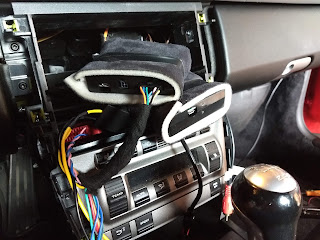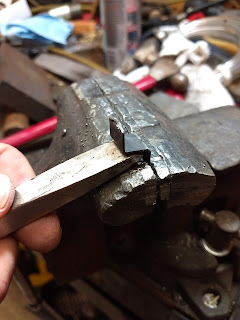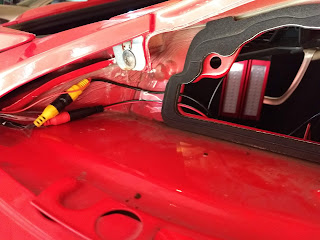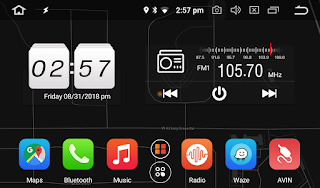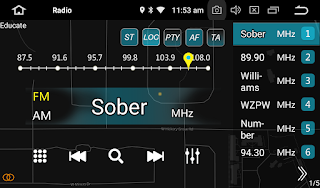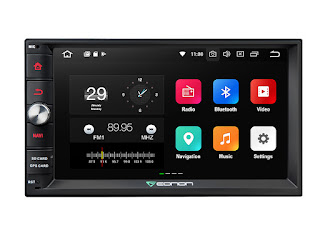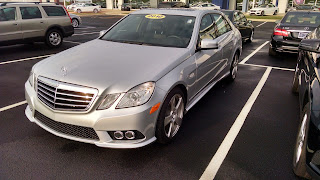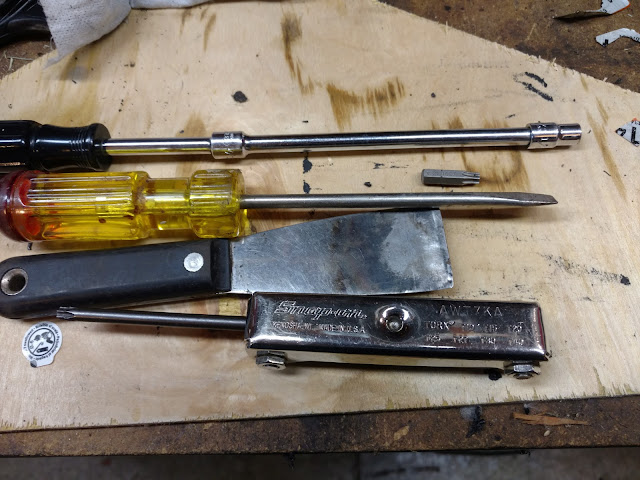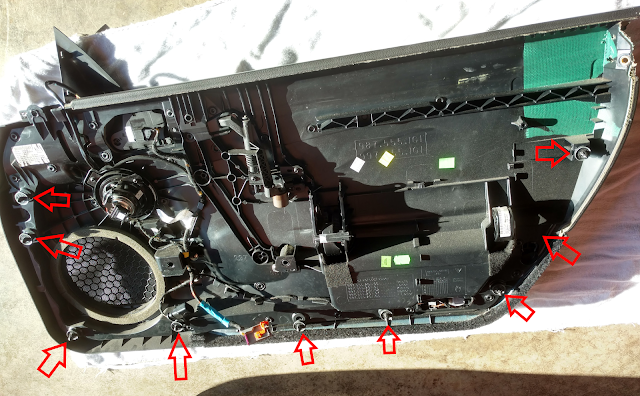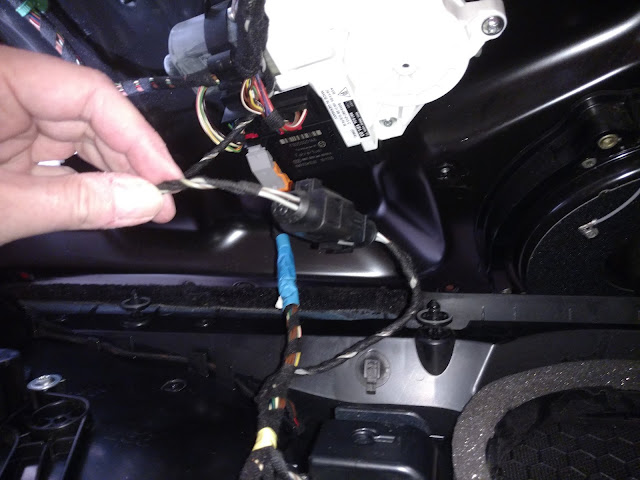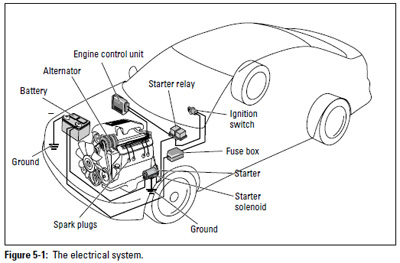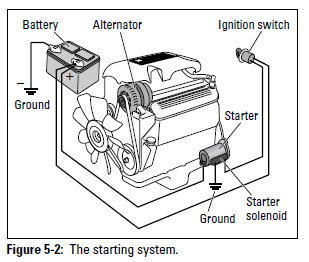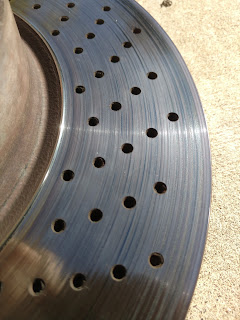As I discussed in my Car Stereo Head Unit Wish List post a while back, I wanted to upgrade my stereo to add some features such as navigation and backup camera. I finally did it. Here is a summary of that installation.
Head Unit Selection
I finally chose the Pumpkin AE0273B-08A. I liked this one because it had:
- A volume knob (a must have)
- Android 8.0
- 4GB RAM (so multiple apps can run smoothly)
- 32GB internal memory (because apps and app data does best here)
- Google Play store (so I can install any apps I want like Waze, Google Maps, etc.)
- Capacitive tough screen (versus resistive or other)
- Backup camera support
- External GPS and WiFi antennas (for better GPS accuracy)
The way I will use this when I am on the road is just hotspot my phone and let the unit connect to it via WiFi (for internet) and Bluetooth (for hands free calling). This way the head unit does all the heavy lifting for navigation,Waze, etc. I can also run Spotify, Amazon Music, Play Music, etc., right in this unit and control it without having to mess with my phone.
I purchased this from Amazon for $299. However you can also buy it directly from Pumpkin for that same price. By the time you read this it will likely be even less as things like this often drop fast. When I first saw this unit it was $349.
I purchased this from Amazon for $299. However you can also buy it directly from Pumpkin for that same price. By the time you read this it will likely be even less as things like this often drop fast. When I first saw this unit it was $349.
Electronics Integration
My 2006 Cayman S has the Bose system which makes this upgrade much more complicated and expensive. The Bose system uses a MOST fiber optic network to communicate between the head unit, CD changer, and amplifier. The car has a 10 speaker system which uses very low impedance speakers as well. There are several paths you can take when making upgrades to this system but here are the most likely:- Replace pretty much everything. Since the speakers are non-standard you would really need to replace all of them except the sub woofer. The Sub woofer has its own amp and you can connect a standard low-level output to it with some modification. Everything else though would need to go.
- Get a MOST gateway to connect into the factory amplifier and retain the amp and speakers. This way you can just replace the head unit and not have to change the rest.
I used a terminal strip to connect the Axxess kit to the Pumpkin wiring as shown in the photos below.
I got the system installed in the car to find that the CAN module (labelled STK760) did not work. That module is responsible for energizing the key switch input to the system and it was not being energized. I called Axxess who makes this kit. They had me measure voltage in the CAN wires. Both wires were at 2.5V. They said this means this CAN network is a slow/symmetric network and so the module in the PO904 kit would not work and I needed the PO90052 instead which has a CAN module labelled STK758. These modules look the same but support the different CAN types.
I received the PO90052 and installed it. Now the CAN module worked. The unit would power up and it supplied the park brake and reverse inputs I needed. Great, except there was still no sound. The MOST module did not work. Rats. I connected my factory stereo to confirm everything else was still working and it was. I messaged Axxess tech support with my problem. He had me send a photo of the wire connection at the MOST module. From that he determined that they had made the wiring incorrectly and that the amp power ON wire (blue/white) needed to be moved over 2 places.
I figured out how to release the terminal and move it over and it worked! Finally. The terminals are released using a small pin from the front (the side that plugs into the module). I pushed the pin into each side of the terminal carefully bending the retaining tabs in to release the terminal. Once you get the terminal out, bend the tabs back out so they will catch when the terminal is placed in the correct spot.
One other thing. The AXXESS adapter did not include the power antenna power wire in the connector for some reason. Since I did not use any of the speaker wires, I just used one of them (green/black) to go into position A5 of the ISO10847 main power connector and wired it to key ON power coming from the AXXESS CAN module. Without this the radio reception is poor.
These modules don't have mounts so you need to wrap them in foam before placing them in the dash or else they will rattle around. These modules do not produce much heat. I happened to have some Alcantara headliner material from a few weeks ago when I replaced the headliner in this car. It's perfect for this as it has foam and the Alcantara is actually a durable covering.
Fitting all of this into the dash in a way that will not rattle around and where you can also fit the stereo is a challenge. I put the CAN module into a opening on the left (US drivers) side. I fit snugly and tucked away clear of the head unit. I put the MOST module directly behind the head unit towards the left. It's important to not king the MOST fiber optic leads as they sharp bends can cause problems and these can break. The bulky ISO connectors also need to be wrapped and tucked out of the way of the head unit. Unfortunately I ended up with 2 ISO connectors: one from the Axxess integration kit that is used for power and ground, and the other from the Pumpkin wiring that has all the speaker level outputs (which I am not currently using).
Installation into dash
Dash Bezel
This was the biggest challenge. I purchased a American International POR911S kit. This kit is actually not good. The plastic side mounts are too thick to fit the Pumpkin head unit. They have little mounting tabs that won't compress to fit the opening because they hit the stereo. If you ever did manage to get a head unit installed, removing it again would be a bear. The only part I used was the dash bezel itself and even that required significant modifications. The opening was too small to fit the Pumpkin properly so I had to trim it, a bunch. I used a router with a very small bit to carefully trim the opening.
Trimming the bezel with a router
I did the trimming by carefully setting the depth and trimming the back side of the opening. Then I finished with a file. I had to trim in many places to make this fit correctly. I think I spend about 4 hours just on the bezel.
Bezel trimmed and set in place
Now I needed a way to retain the bezel. The bezel kit was set up to have the side mounts also hold the bezel but this will not work in my installation with custom mounts. I needed to make clips that had some spring to them that would fit into the slots in the bezel and behind the side panels that fit on either side of the center console. These side panels clip and screw in place well so these clips would hold the bezel firmly in place once the side panels were installed. I bought some 90 degree speed nuts from the hardware store and began modifying them into retention clips.
These will fit in the bezel slots in the sides and then catch behind the center stack trim panels of the Cayman to retain the bezel. I also attached felt pads like the ones you use on kitchen cabinets to create for constant pressure to hold the bezel tight.
Head Unit Mounts
Now I needed to fabricate mounts for the Pumpkin since the ones in the kit were not going to work. I started with raw sheet metal from the hardware store. I used the plastic mounts from the POR911S kit as patterns. I used a sheet metal cutting blade on the table saw to carefully cut the metal for the mounts.
I marked it in the image above. I then removed the mounts and carefully bent this front edge. This limits how deep the stereo goes into the dash to meet the bezel properly. I also had to trim the bent edge to eliminate interference with the bezel. I trimmed the back of the bezel to also allow proper clearance. Once I got everything to fit, I cleaned, primed, and painted these new mounts so they would not rust. Obviously I was not going for pretty here.
Next I needed to figure out how to actually retain the radio and the bezel. The factory mount had a set screw on the passengers side. I noticed the drivers side also had a spot for a set screw so I installed one. Now I had set screws on both sides. I set the head unit in place and ran the screws in until they left marks on the mounts. I then drilled small holes right where these screws contacted so the screw would not lock into the holes.
Great, now the head unit mounts firmly in place. I do track days and solid mounts are very important.
Backup Camera
When I first got the Pumpkin I powered it up on the table and set it up, installing the apps I wanted and configuring it. I connected an old camcorder to it to test the backup camera and video inputs. The Pumkin did not recognize the signal. I also noticed that Pumpkin says to use their backup camera to ensure compatibility. So fine, I bought their camera for $15. When it showed up I immediately noticed how huge it was.
I went ahead and mounted this one in the front for a front facing parking camera. It fit in the pocket under the front license plate. Since this and the pocket are all black, it blends right in.
Then I started searching for a better place to mount this and route the wires. It was looking very grim. There is really not a good place on this car for a camera and even if I could find a spot, how would I route the wires? It was looking like I would have to remove the whole bumper cover or something to route the wires. The exhaust system spans the whole back of this car so running wires from underneath was not going to work. Then I found this thread on Planet 9. I also found a better and much smaller backup camera on Amazon from TOPTIERPRO. This had a mounting bracket that went behind the license plate instead of in top and the camera was much smaller.
I removed the taillight assembly on the right side and the right side license plate assembly. Now you can actually see right through from the taillight opening to the license plate light opening. Nice.
I used a coat hanger, cut it and bent it straight with a hook on the end and pulled the wires right though. I used a small round file to make a notch in the back inner corner of the license light opening for the wires and snapped the license light back in place.
I connected the camera power and ground wires to the backup light wire and taillight ground as shown below using a terminal block. Note that this connector is inside the car, protected from weather.
I tucked the camera wires under the taillight seal which is a thick foam. I also taped the wires in place and tapes the connectors which are outside the interior and not fully protected from weather.
It works very well. This camera has very bright white LED lights to assist the backup lights.
The backup camera function does not require that Android be booted up to work. When reverse is selected the unit directly feeds the camera to the screen.
The Pumpkin has a video in you can connect this to. I put a quick link to this video in on the bottom row of the main UI screen. Tap that button and the camera pops right up.
Then I started searching for a better place to mount this and route the wires. It was looking very grim. There is really not a good place on this car for a camera and even if I could find a spot, how would I route the wires? It was looking like I would have to remove the whole bumper cover or something to route the wires. The exhaust system spans the whole back of this car so running wires from underneath was not going to work. Then I found this thread on Planet 9. I also found a better and much smaller backup camera on Amazon from TOPTIERPRO. This had a mounting bracket that went behind the license plate instead of in top and the camera was much smaller.
I removed the taillight assembly on the right side and the right side license plate assembly. Now you can actually see right through from the taillight opening to the license plate light opening. Nice.
I used a coat hanger, cut it and bent it straight with a hook on the end and pulled the wires right though. I used a small round file to make a notch in the back inner corner of the license light opening for the wires and snapped the license light back in place.
I connected the camera power and ground wires to the backup light wire and taillight ground as shown below using a terminal block. Note that this connector is inside the car, protected from weather.
I tucked the camera wires under the taillight seal which is a thick foam. I also taped the wires in place and tapes the connectors which are outside the interior and not fully protected from weather.
It works very well. This camera has very bright white LED lights to assist the backup lights.
The backup camera function does not require that Android be booted up to work. When reverse is selected the unit directly feeds the camera to the screen.
Parts and Tools Needed
Parts List
- Pumpkin AE0273B-08A Android stereo head unit if found on Amazon.
- American International POR911S dash kit.
- Axxess PO90052 or PO904 head unit replacement kit. There are other options and this is only needed if you plan to retain the Bose amp (and that you have the Bose sound system).
- Sheet metal stock. I used 22 gauge steel.
- 90 degree angle speed nuts to be modified to retain the bezel.
- Screw to retain head unit similar to the one on the right side.
- Small screws and nuts for mounts to slide into opening.
- Terminal strip to connect Pumpkin wiring to the Axxess integration kit.
- Primer and paint to paint the fabricated mounts so they don't rust.
- Antenna adapter for the AM/FM antenna lead.
- TOPTIERPRO backup camera if found on Amazon. Others will also work.
Tools List
- Screwdrivers.
- Torx drivers.
- 7mm wrench.
- wire cutters and strippers.
- Router with 3/16" straight bit.
- Table saw with sheet metal cutting blade.
- Hammers and chisels to make mounts and bezel clips.
- Plastic prying tool to remove trim.
Using the System
Sound
At low to mid volume the sound seems very similar to before, as expected. From about 3/4 volume to max it seems like it may not get quite as loud as before. It still gets plenty loud for me. I would guess it is maybe 15% less loud at max. As I mentioned, I can't fade the sound since the Axxess kit has only 2 channels for input.
I could easily wire the subwoofer output from the Pumpkin to the Bose subwoofer since this has its own amplifier with line inputs. This would enable the subwoofer control from the Pumkin so you could adjust the subwoofer level. I did not bother with this as it seems fine running the subwoofer through the factory Bose system. I doubt this would improve sound quality but it would give the user a bit more control.
9/7/2018 update: I installed an AXXESS AX-LDBK Universal Line Output Converter Power Converter between the head unit and the MOST adapter. This gives the ability to add some gain to the line level signal going to the MOST box. I was able to completely restore the sound level and quality to match the factory head unit. This little $35 unit is well worth it.
9/7/2018 update: I installed an AXXESS AX-LDBK Universal Line Output Converter Power Converter between the head unit and the MOST adapter. This gives the ability to add some gain to the line level signal going to the MOST box. I was able to completely restore the sound level and quality to match the factory head unit. This little $35 unit is well worth it.
UI
The UI is good. It seems very responsive. The launcher they provided seems good too. This has less system apps than most Android devices and this makes sense. The use cases for a car stereo head unit are of course different. The apps they provided are simple and functional. You can of course install different launchers, some focused on car stereos like this. I have VLC Player installed and it gives a bit better experience for navigating a large music and video library than their apps. The great thing about having Android in the dash is flexibility.
The screen resolution is 1024x600. Apps with a light theme, such as Google Maps, look a bit washed out. Dark theme apps look great. There is no contrast adjustment in the UI either but it can be done by disassembling the unit. It has a dash illumination input that will dim the dash a predetermined amount (could not find any adjustment for this) when the dash lights are turned ON. This can also be used to turn ON the button illumination but you can also configure it to illuminate the button with key power too.
The Android 8.0 OS is very bare bones and focused on being a car stereo head unit. It reports as a Rockchip PX5 tablet. It lacks several common Android settings such as developer settings. You can put it in developer mode but still no developer settings are shown. It seems the only widgets that work are the ones that are pre-installed. I installed several apps that generally have widgets yet none are available. Some apps like Google Contacts will load but when you open them and it asks for an account it will not log in to the same account the connected phone has. After I tried this though I realized there is not really a use case where I want to use the contact app. If you go to the Phone app in the Pumpkin it does sync your phone contacts there. I am not able to get any apps to start at boot. I have Tasker installed and set up to start at boot but it never does.
Unlike many, I really don't like a touchscreen while driving. I actually really like the Mercedes Benz Command UI where it has buttons to get to things like radio, navigation, etc., and a center console knob as well as dedicated volume knob, next/last buttons and more. You can feel and control them without taking your eyes off the road. This Pumpkin can be controlled with Bluetooth or USB input devices such as a mouse, trackball, or media controllers. I connected a standard PC USB mouse and it worked fine. I found many simple Bluetooth media controllers that should also work giving physical buttons for play/pause, previous/next, and more. There is this thread on XDA Developers though which indicates this may not work. Ideally I would like to make a controller that is similar to the Command control and this should be very doable. Besides USB and Bluetooth, I could also set up dedicated buttons using the steering wheel control inputs. This can be done with simple switches and resistors and the Pumpkin has a mapping utility in it already.
The screen resolution is 1024x600. Apps with a light theme, such as Google Maps, look a bit washed out. Dark theme apps look great. There is no contrast adjustment in the UI either but it can be done by disassembling the unit. It has a dash illumination input that will dim the dash a predetermined amount (could not find any adjustment for this) when the dash lights are turned ON. This can also be used to turn ON the button illumination but you can also configure it to illuminate the button with key power too.
The Android 8.0 OS is very bare bones and focused on being a car stereo head unit. It reports as a Rockchip PX5 tablet. It lacks several common Android settings such as developer settings. You can put it in developer mode but still no developer settings are shown. It seems the only widgets that work are the ones that are pre-installed. I installed several apps that generally have widgets yet none are available. Some apps like Google Contacts will load but when you open them and it asks for an account it will not log in to the same account the connected phone has. After I tried this though I realized there is not really a use case where I want to use the contact app. If you go to the Phone app in the Pumpkin it does sync your phone contacts there. I am not able to get any apps to start at boot. I have Tasker installed and set up to start at boot but it never does.
Unlike many, I really don't like a touchscreen while driving. I actually really like the Mercedes Benz Command UI where it has buttons to get to things like radio, navigation, etc., and a center console knob as well as dedicated volume knob, next/last buttons and more. You can feel and control them without taking your eyes off the road. This Pumpkin can be controlled with Bluetooth or USB input devices such as a mouse, trackball, or media controllers. I connected a standard PC USB mouse and it worked fine. I found many simple Bluetooth media controllers that should also work giving physical buttons for play/pause, previous/next, and more. There is this thread on XDA Developers though which indicates this may not work. Ideally I would like to make a controller that is similar to the Command control and this should be very doable. Besides USB and Bluetooth, I could also set up dedicated buttons using the steering wheel control inputs. This can be done with simple switches and resistors and the Pumpkin has a mapping utility in it already.
System
Powering up from completely OFF takes about 15s to 20s. It has a mode where it suspends instead of completely shutting down and waking from that mode is pretty much instant. The downside of that instant mode is it will use more of your cars battery. You can set how long the key is OFF before it fully shuts down. I found that the Axxess MOST module takes several seconds to power up and start delivering sound anyway, something like 8s.
This unit has 32GB on-board which is more than enough space for all the apps and their main data. It has 2 micro-SD card slots as well as 2 USB ports. The documentation says "Support SD card/ USB drive up to 128GB". I presume this means each can have 128GB? Not sure but it is more than enough anyway. I have one 8GB and one 16GB micro-SD cards in it now. I also had a 64GB USB drive connected. All worked fine.
I set up my phone as a WiFi hotspot that the Pumpkin connects to for a network connection when driving. I used Tasker to automate this so that when my phone connects to the Pumpkin for hands-free calling, it also enables the WiFi hotspot on my phone. When my phone Bluetooth disconnects from the Pumpkin at key OFF the hotspot is returned to its previous state (OFF in my case).
Tasker profile to see the car connected and turn ON hotspot
This unit has 32GB on-board which is more than enough space for all the apps and their main data. It has 2 micro-SD card slots as well as 2 USB ports. The documentation says "Support SD card/ USB drive up to 128GB". I presume this means each can have 128GB? Not sure but it is more than enough anyway. I have one 8GB and one 16GB micro-SD cards in it now. I also had a 64GB USB drive connected. All worked fine.
I set up my phone as a WiFi hotspot that the Pumpkin connects to for a network connection when driving. I used Tasker to automate this so that when my phone connects to the Pumpkin for hands-free calling, it also enables the WiFi hotspot on my phone. When my phone Bluetooth disconnects from the Pumpkin at key OFF the hotspot is returned to its previous state (OFF in my case).
Tasker profile to see the car connected and turn ON hotspot
Final Thoughts
This installation was more difficult than I expected but I would do it again. I just got it done so I have not used it much yet. I may add a follow-up in a few months.
I noticed deep in the "factory settings" menu that there are CAN (car data link) settings for many manufacturers including Porsche. I asked on the Pumpkin support site about this and hope to get some info from them.
I noticed deep in the "factory settings" menu that there are CAN (car data link) settings for many manufacturers including Porsche. I asked on the Pumpkin support site about this and hope to get some info from them.
Short demonstration after the installation
(if the video does not play click "YouTube" to open it in YouTube app or separate browser tab)
Update 9-2020
Using a touch screen in a Porsche sports car on Illinois roads does not work well at all. Even when bracing your hand with your thumb to try a touch gesture, it is too easy for your finger to slide and the OS think you are giving a slide gesture instead of touch. I much prefer the knob my Mercedes Command systems have. My Porsche does not have steering wheel controls. I decided I would add a few switches to allow for some more controls and depend less on the touch screen. After looked at many options I settled on a membrane switch in the ash tray (which I never use anyway). I bought the switch on Amazon for under $10.

I used a simple terminal strip and 4, 100 Ohm resistors.
The head unit has the key-mapping tool build in. You just open the tool, press a button, and then select the short and long press responses you want.






